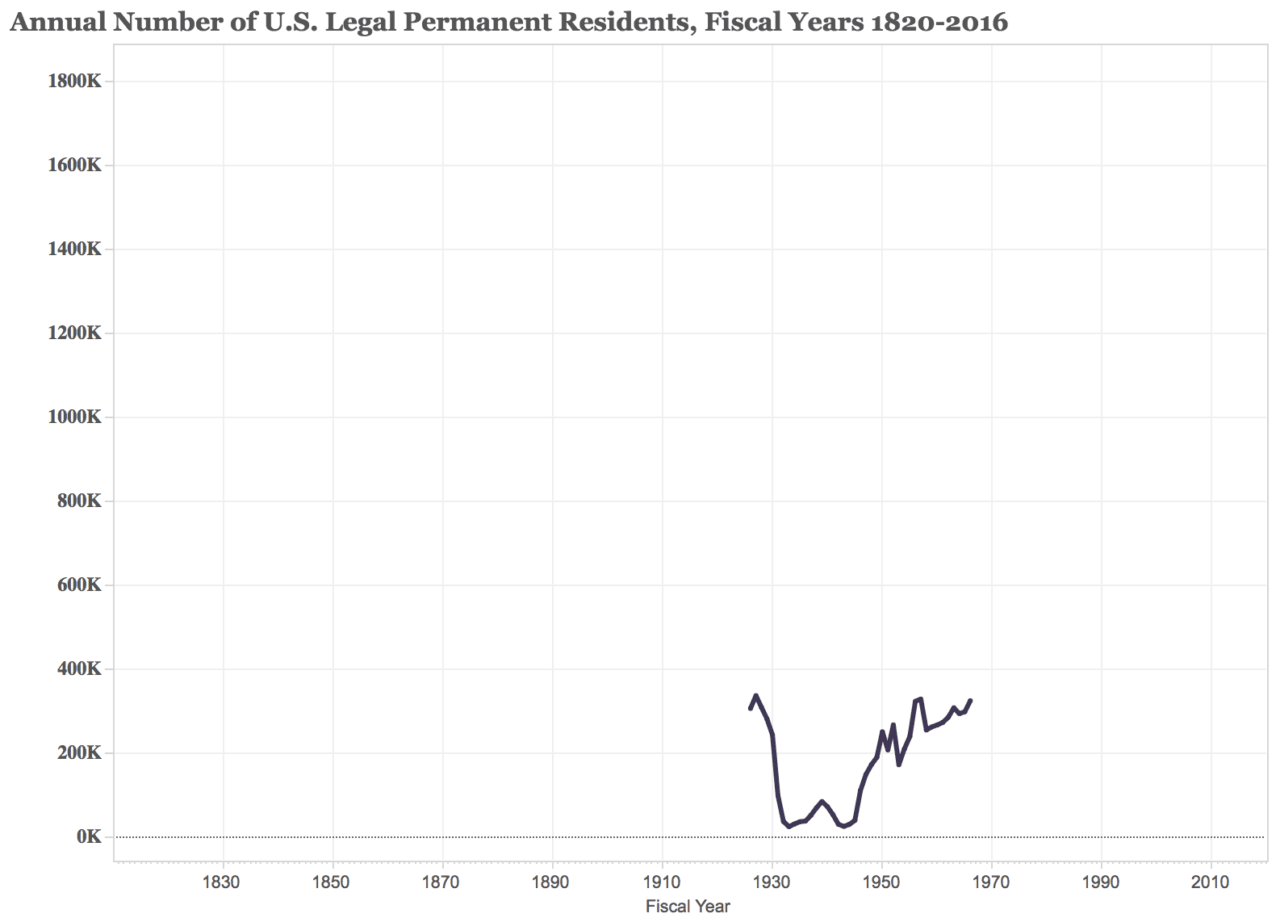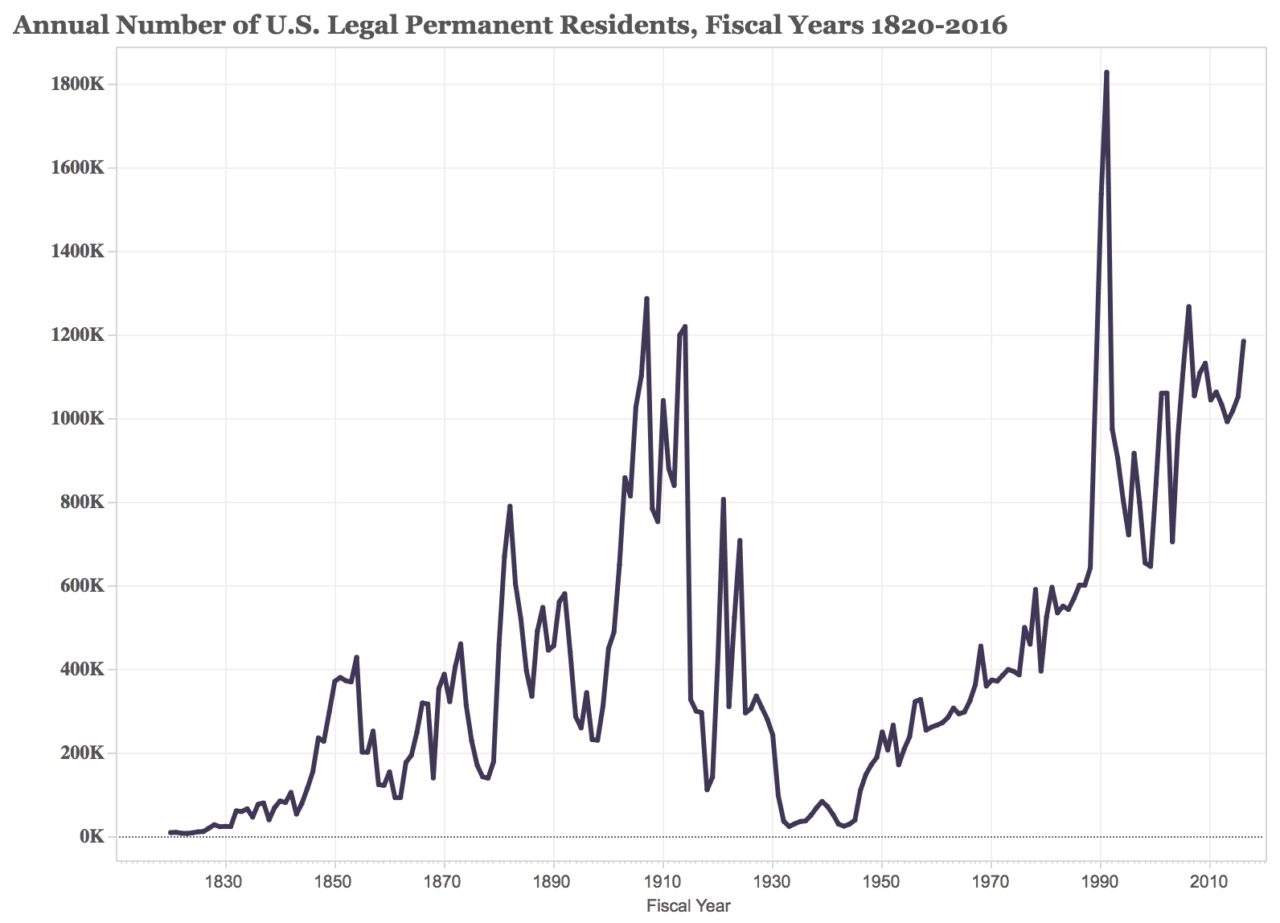The last period in United States history that saw a booming, record-hitting foreign-born population was met with a near immigration moratorium that lasted for about 40 years.
As Breitbart News’s Neil Munro reported, the latest data from the U.S. Census Bureau marks a nearly 108-year record high of immigration to the country. In 2017, the foreign-born population boomed to 13.7 percent, encompassing 44.5 million immigrants.
That 44.5 million includes roughly 22 million naturalized citizens, 11 million other residents – including more than 1.5 million foreign temporary visa-workers – plus about 11 million illegal aliens.
The last time the U.S. foreign-born population was this high was in 1910 when immigrants made up 14.7 percent of the total country’s population.
The country’s last immigration boom — between 1900 and 1920 — was eventually met with a near immigration moratorium. Between 1925 and 1966, the yearly U.S. legal immigration level did not exceed 327,000 admissions, a four-decades-long near moratorium that allowed the massive inflows of immigrants from before 1925 the ability to assimilate.

Between 1925 and 1966, the number of legal immigrants admitted to the U.S. every year did not exceed 326,000. (Migration Policy Institute)
Since major changes were enacted in 1965 and in the 1990s to the U.S. legal immigration system — changes that allow foreign nationals to bring as many foreign relatives to the country as they want — legal immigration levels have continued booming for more than five decades.
For example, since 1980, the number of legal immigrants admitted to the U.S. every year has not dipped below 525,000. Since 1999, annual legal immigration levels have not dropped below 645,000. And since 2004, the number of legal immigrants admitted to the U.S. every year has not dipped below 957,000 admissions a year.

Immigration to the U.S. has boomed to historic levels since 1966, with foreign-born residents now making up 13.7 percent of the total U.S. population. (Migration Policy Institute)
President Trump, along with Sen. Tom Cotton (R-AR) and Sen. David Perdue (R-GA), has sought to bring traditional immigration levels back to the country’s national policy through their proposed “RAISE Act” legislation.
The RAISE Act seeks to follow through on the immigration recommendations made by Civil Rights icon, Rep. Barbara Jordan (D-TX), who demanded a major reduction to the mass legal immigration levels of the 1990s, finding that the policy had hurt America’s working and middle class the most.
Cotton and Perdue’s RAISE Act would limit legal immigration to no more than 500,000 a year, down from the more than a million that are admitted currently every year, and would cap yearly refugee resettlements to 50,000 a year. The Trump-endorsed legislation would also end the process known as “chain migration,” whereby newly naturalized citizens can bring their foreign relatives to the U.S.
Tom Cotton's RAISE Act is a revival to Barbara Jordan's 'Americanization' immigration legacy… https://t.co/5JOWHAEMqe
— John Binder 👽 (@JxhnBinder) August 13, 2017
U.S. voters have hinted that they favor a near immigration moratorium — as done in the past — since the country’s immigration flow has boomed to historic levels. In an April Harvard/Harris Poll, two out of three voters said they supported Trump’s plan to cut legal immigration levels down to at least 500,000 admissions a year.
A similar Harvard/Harris Poll in January found that more Americans support zero immigration to the country than they do current legal immigration levels. Black Americans, in the same Harvard/Harris Poll, were found to be the most supportive of a near immigration moratorium. Nearly half of black Americans said they would like to see between one and 250,000 legal immigrants brought to the U.S. a year.
Mass immigration has come at the expense of America’s working and middle class, which has suffered from poor job growth, stagnant wages, and increased public costs to offset the importation of millions of low-skilled foreign nationals.
Four million young Americans enter the workforce every year, but their job opportunities are further diminished as the U.S. imports roughly two new foreign workers for every four American workers who enter the workforce. Even though researchers say 30 percent of the workforce could lose their jobs due to automation by 2030, the U.S. has not stopped importing more than a million foreign nationals every year.
For blue-collar American workers, mass immigration has not only kept wages down but in many cases decreased wages, as Breitbart News reported. Meanwhile, the U.S. continues importing more foreign nationals with whom working-class Americans are forced to compete. In 2016, the U.S. brought in about 1.8 million mostly low-skilled immigrants.
John Binder is a reporter for Breitbart News. Follow him on Twitter at @JxhnBinder.

COMMENTS
Please let us know if you're having issues with commenting.